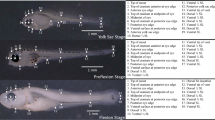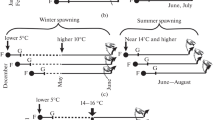Abstract
The difference in morphology between zoeae of Cancer magister Dana from Alaskan and Californian waters was documented to determine if the morphological variation is attributable to environmental influences. First-stage zoeae from Alaska have significantly longer carapace spines than zoeae from central California. The dorsal, rostral and lateral carapace spines were 14, 14 and 29% longer, respectively, in the Alaskan zoeae. The effect of temperature was tested on zoeal morphology as it is an obvious environmental difference between Alaskan and Californian waters. Ovigerous female crabs collected in southeastern Alaska in 1984 were held at 1°, 5°, 10° and 15° C until hatching occurred. Eggs were sampled seven times during the incubation period, and relative mortality, egg diameter and development stage were measured. All of the crabs and eggs at 1° C died before hatching occurred. Egg mortality averaged less than 2% in the other temperature treatments. Egg diameter increased significantly over the incubation period for all temperatures. Developmental rate of the embryos was inversely related to temperature. Hatching first occurred in 42 d at 15° C, 60 at 10° C and 160 d at 5° C. Newly hatched zoeae were collected and body length, dorsal, rostral and lateral carapace spines were measured. Significant differences existed between all temperatures for all spine lengths, with longer spines occurring at lower temperatures. Zoeal body lengths were also significantly different between the three temperatures. The results of this study question the use of spine lengths to distinguish similar larval species.
Similar content being viewed by others
Literature cited
Ally, J. R. R.: Description of the laboratory-reared larvae of Cancer gracilis Dana, 1852 (Decapoda, Brachyura). Crustaceana 28, 231–246 (1975)
Anderson, W. R.: A description of laboratory-reared larvae of the yellow crab, Cancer anthonyi Rathbun (Decapoda, Brachyura), and comparisons with larvae of Cancer magister Dana and Cancer productus Randall. Crustaceana 34, 56–68 (1978)
Anger, K., R. R. Dawirs, V. Anger, J. W. Goy and J. D. Costlow: Starvation resistance in first stage zoeae of brachyuran crabs in relation to temperature. J. Crustacean Biol. (Lawrence, Kansas) 1, 518–525 (1981)
Armstrong, D. A., L. S. Incze, D. L. Wencker and J. L. Armstrong: Distribution and abundance of decapod crustacean larvae in the southeastern bering Sea with emphasis on commercial species. NOAA Office mar. Pollut. Assessmt OCSEAP Rep. Proj. No. NA81-RAC-00059, 1–388 (1983)
Austin, W. C.: An annotated checlist of marine invertebrates in the cold temperate Northeast Pacific, 682 pp. Cowitchan Bay, British Columbia: Khoyatan Marine Laboratory 1985
Barr, L. and N. Barr: Under Alaskan seas, 208 pp. Anchorage, Alaska: Alaska Northwest Publishing Co. 1983
Bookhout, C. G. and J. D. Costlow, Jr.: Larval development of Portunus spinicarpus reared in the laboratory. Bull. mar. Sci. 24, 20–51 (1974)
Boolootian, R. A., A. C. Giese, A. Farmanfarmaian and J. Tucker: Reproductive cycles of five west coast crabs. Physiol. Zoöl. 32, 213–220 (1959)
Butler, T. H.: A bibliography of the Dungeness crab, Cancer magister Dana. Tech. Rep. Fish. Res. Bd Can. 1, 1–12 (1967)
Costlow, J. D., Jr., C. G. Bookhout and R. Monroe: The effect of salinity and temperature on larval development of Sesarma cinereum (Bosc) reared in the laboratory. Biol. Bull. mar. biol. Lab., Woods Hole 118, 183–202 (1960)
Costlow, J. D., Jr., C. G. Bookhout and R. Monroe: Studies on the larval development of the crab, Rhithropanopeus harrisii (Gould). I. The effect of salinity and temperature on larval development. Physiol. Zoöl. 39, 81–100 (1966)
Dahlstrom, W. A. and P. W. Wild: A history of Dungeness crab fisheries in California. Fish Bull. Calif. 172, 7–23 (1983)
Dawirs, R. R.: Effects of temperature and salinity on larval development of Pagurus bernhardus (Decapoda, Paguridae). Mar. Ecol. Prog. Ser. 1, 323–329 (1979)
Gore, R. H., C. L. Van Dover and K. A. Wilson: Studies on decapod Crustacea from the Indian River region of Florida. XX. Micropanope barbadensis (Rathbun, 1921): the complete larval development under laboratory conditions (Brachyura, Xanthidae). J. Crustacean Biol. (Lawrence, Kansas) 1, 28–50 (1981)
Hart, J. F. L.: The larval development of British Columbia Brachyura. II. Majidae, Subfamily Oregoniinae. Can. J. Zool. 58, 539–546 (1960)
Kessler, D. W.: Alaska's saltwater fishes and other sea life, 358 pp. Anchorage, Alaska: Alaska Northwest Publishing Co. 1985
Lang, W. H. and A. M. Young: The larval development of Clibanarius vittatus (Bosc) (Crustacea: Decapoda; Diogenidae) reared in the laboratory. Biol. Bull. mar. biol. Lab., Woods Hole 152, 84–104 (1977)
LeBour, M. V.: The larval stages of the Plymouth Brachyura. Proc. zool. Soc. Lond. 1928(2), 473–560 (1928)
Mayr, E.: Systematics and the origin of species, 334 pp. New York: Columbia University Press 1942
Mottley, C. McC.: The effect of temperature during development on the number of scales in the Kamloops trout, Salmo kamloops Jordan. Contr. Can. Biol. Fish. 8, 254–263 (1934)
Ong, K.-S. and J. D. Costlow, Jr.: The effect of salinity and temperature on the larval development of the stone crab, Menippe mercenaria (Say), reared in the laboratory. Chesapeake Sci. 11, 16–29 (1970)
Poole, R. L.: A description of laboratory-reared zoeae of Cancer magister Dana, and megalopae taken under natural conditions (Decapoda, Brachyura). Crustaceana 11, 83–97 (1966)
Preston, N.: The combined effects of temperature and salinity on hatching success and the survival, growth, and development of the larval stages of Metapenaeus bennettae (Racek and Dall). J. exp. mar. Biol. Ecol. 85, 57–74 (1985)
Rathbun, M. J.: Decapod Crustacea of the northwest coast of North America. Harriman Alaska Exped. 10, 1–210 (1904). (New York: Doubleday, Page & Co. Reprinted: Washington, D.C.: Smithsonian Institution 1910)
Rathbun, M. J.: The cancroid crabs of America of the families Eurvalidae, Portunidae, Atelecyclidae, Cancridae, and Xanthidae. Bull. U.S. natn. Mus. 152, 1–609 (1930)
Ray, C.: The application of Bergman's and Allen's rules to the poikilotherms. J. Morph. 106, 85–108 (1960)
Reilly, P. N.: Ocean and estuarine conditions during Dungeness crab critical stage larval studies. Fish Bull. Calif. 172, 43–56 (1983)
Sandifer, P. A.: Effects of temperature and salinity on larval development of grass shrimp, Palaemonetes vulgaris (Decapoda, Caridea). Fish. Bull. U.S. 71, 115–123 (1973)
Scotto, L. E.: Larval development of the Cuban stone crab, Menippe modifrons (Brachyura, Xanthidae), under laboratory conditions with notes of the status of the family Menippidae. Fish. Bull. U.S. 77, 359–386 (1979)
Stuck, K. C. and F. M. Truesdale: Larval and early postlarval development of Lepidopa benedicti Schmitt, 1935 (Anomura: Albuneidae) reared in the laboratory. J. Crustacean Biol. (Lawrence, Kansas) 6, 89–110 (1986)
Trask, T.: A description of laboratory-reared larvae of Cancer productus Randall (Decapoda, Brachyura) and a comparison to larvae of Cancer magister Dana. Crustaceana 18, 131–146 (1970)
Wear, R. G.: Incubation in British decapod Crustacea, and the effects of temperature on the rate and success of embryonic development. J. mar. biol. Ass. U.K. 54, 745–762 (1974)
Wencker, D. L., L. S. Incze and D. A. Armstrong: Distinguishing between Chionocetes bairdi and C. opilio zoeae collected in the southeast Bering Sea. Alaska Sea Grant Rep. (Univ. Alaska, Anchorage) 82-10, 219–230 (1982). (Proceedings of the International Symposium on the genus Chionoecetes)
Wild, P. W.: Effects of seawater temperature on spawning, egg development, hatching success, and population fluctuations of the Dungeness crab, Cancer magister. Fish Bull. Calif. 172, 197–213 (1983)
Wilson, K. A., L. E. Scotto and R. H. Gore: Studies on decapod Crustacea from the Indian River region of Florida. XIII. Larval development under laboratory conditions of the spider crab Mithrax forceps (A. Milne Edwards, 1875) (Brachyura: Majidae). Proc biol. Soc. Wash. 92, 307–327 (1979)
Author information
Authors and Affiliations
Additional information
Communicated by P. C. Schroeder, Pullman
Rights and permissions
About this article
Cite this article
Shirley, S.M., Shirley, T.C. & Rice, S.D. Latitudinal variation in the Dungeness crab, Cancer magister: zoeal morphology explained by incubation temperature. Mar. Biol. 95, 371–376 (1987). https://doi.org/10.1007/BF00409567
Accepted:
Issue Date:
DOI: https://doi.org/10.1007/BF00409567




